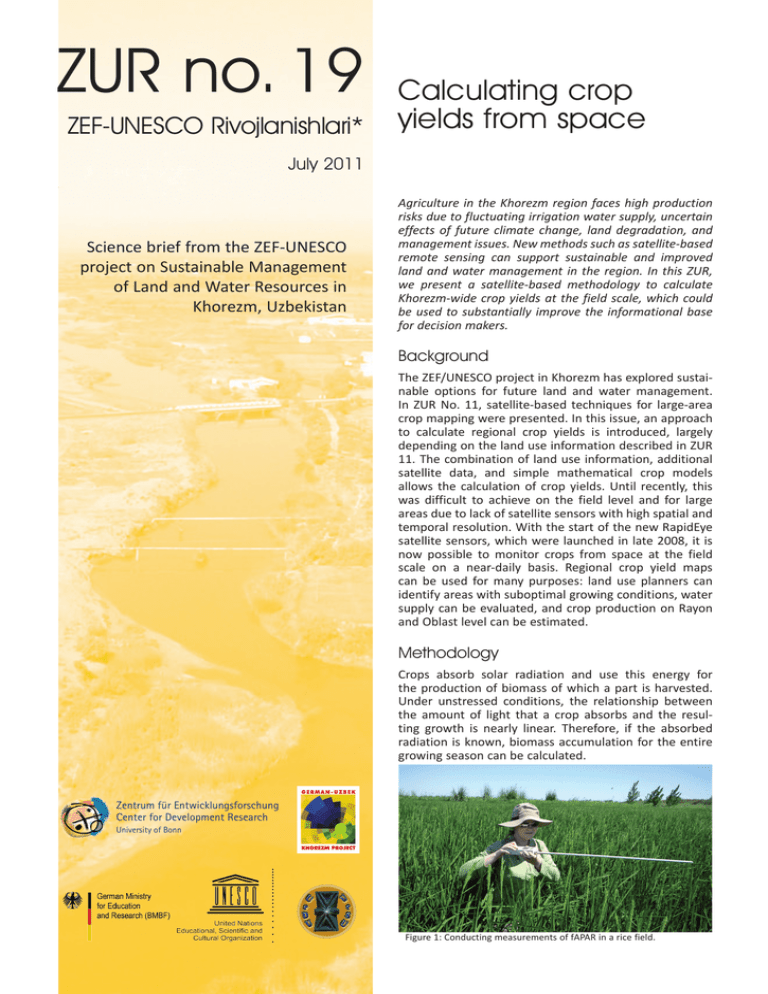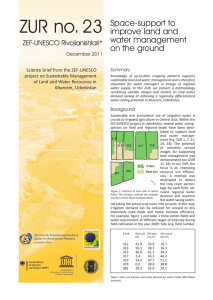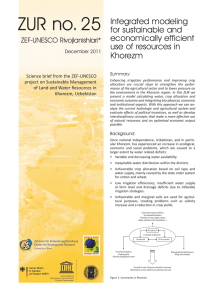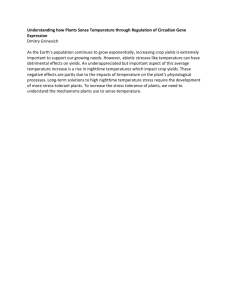ZUR no. 19 Calculating crop yields from space
advertisement

ZUR no. 19 ZEF-UNESCO Rivojlanishlari* Calculating crop yields from space July 2011 Science brief from the ZEF-UNESCO project on Sustainable Management of Land and Water Resources in Khorezm, Uzbekistan Agriculture in the Khorezm region faces high production risks due to fluctuating irrigation water supply, uncertain effects of future climate change, land degradation, and management issues. New methods such as satellite-based remote sensing can support sustainable and improved land and water management in the region. In this ZUR, we present a satellite-based methodology to calculate Khorezm-wide crop yields at the field scale, which could be used to substantially improve the informational base for decision makers. Background The ZEF/UNESCO project in Khorezm has explored sustainable options for future land and water management. In ZUR No. 11, satellite-based techniques for large-area crop mapping were presented. In this issue, an approach to calculate regional crop yields is introduced, largely depending on the land use information described in ZUR 11. The combination of land use information, additional satellite data, and simple mathematical crop models allows the calculation of crop yields. Until recently, this was difficult to achieve on the field level and for large areas due to lack of satellite sensors with high spatial and temporal resolution. With the start of the new RapidEye satellite sensors, which were launched in late 2008, it is now possible to monitor crops from space at the field scale on a near-daily basis. Regional crop yield maps can be used for many purposes: land use planners can identify areas with suboptimal growing conditions, water supply can be evaluated, and crop production on Rayon and Oblast level can be estimated. Methodology Crops absorb solar radiation and use this energy for the production of biomass of which a part is harvested. Under unstressed conditions, the relationship between the amount of light that a crop absorbs and the resulting growth is nearly linear. Therefore, if the absorbed radiation is known, biomass accumulation for the entire growing season can be calculated. Zentrum für Entwicklungsforschung Center for Development Research University of Bonn Figure 1: Conducting measurements of fAPAR in a rice field. Combined with a crop map and an in-situ derived harvest index, yield predictions become possible. The amount of light energy absorbed at the crop canopy (fraction of absorbed photosynthetically active radiation, fAPAR) can be measured from optical sensors mounted at satellites. For calibration of the satellite measurements researchers of the ZEF/UNESCO project conducted in-situ measurements of fAPAR for cotton and rice fields (Figure 1). Extreme temperatures and high vapor pressure deficits alter the relationship between fAPAR and crop growth rate significantly. The latter is used as a proxy for water stress caused by inadequate irrigation water supply, which is the most important limiting factor for crop growth in the Khorezm region. Meteorological stations, operated by the ZEF/UNESCO project, allowed inferring these parameters on a daily basis and incorporating them in the crop growth model. Biomass and crop yield can thus be calculated for each single field in Khorezm. The model predictions can be further improved by using parameters that have been calibrated to local conditions by project researchers (harvest index and crop-specific maximum light use efficiency). Due to the high spatial resolution of the satellites, areas that show different growth conditions within a larger field can be detected (Figure 2, inset). At the moment there are, however, a few hurdles to overcome before this model can be used in improving land and water management. First, the use of remote sensing data and methods requires a certain amount of training of potential users. Currently, the ZEF/UNESCO project strives to increase this know-how in the region, e.g. by training seminars. Figure 3: Comparison between total measured and modelled cotton yield from different fields of the Cotton Research Station. Second, awareness for new methodologies has to be raised. There are different stakeholders, like Water Users Associations, land use planners or farmers managing large areas, who could benefit from the model presented here. The ‘Follow the Innovation’ (FTI) approach of the Khorezm project (ZUR No. 10) could be used to introduce this new technology to stakeholders. If this has to work out, simple and easy-to-use information products have to be generated. Maps showing crop yields on single fields or the aggregation of this information on WUA level could be the first step on the way to introducing new and promising technologies in the agricultural sector of Khorezm. Figure 2: Map of the cotton yield at field level in Khorezm (2009). The inset displays a part of the irrigation system and shows the in-field variability of crop yield. Acknowledgements The authors would like to thank the German Aerospace Agency (DLR) for providing data from the RapidEye Science Archive (RESA). Photo provided by Andrea Ehammer. Results and recommendations Figure 2 shows the calculated cotton yields at field scale for the Khorezm region. The spatial patterns of high and low yields can easily be inferred. It also demonstrates the ability to capture within-field yield variability, which can be used for improved field management. The mean cotton yield in 2009 was estimated at 1.97 t/ha, whereas the mean rice yield was 4.85 t/ha. In order to assess the accuracy of the model, we compared our results with actual crop yield data that was collected at the Cotton Research Station of Urgench. The modeled crop yields concurred with the field measurements (Figure 3). The presented approach has a great potential for improving crop production and resource use in the Khorezm region. The model can be used to identify unproductive fields and improve irrigation water management. Especially in dry years with limited water supply, the model can help to optimize regional crop production and water allocation. IMPRINT Authors: Sebastian Fritsch, Christopher Conrad, Gunther Schorcht, and Ahmad M. Manschadi All the authors work or are affiliated with the ZEF/UNESCO project in Uzbekistan. Editor: Alma van der Veen (ZEF) * ZUR is an abbreviation of ZEF-UNESCO Rivojlanishlari, meaning ZEF-UNESCO Developments. The ZUR science briefs publish scientific project output with policy relevance on a regular basis. Published by the Center for Development Research (ZEF) University of Bonn, Germany Uzbekistan Project Office phone: # 49 228 731917 or 734924 e-mail: khorezm@uni-bonn.de homepage:http://www.khorezm.zef.de/ ZUR no. 19 July 2011





